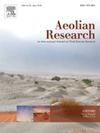Changes in aeolian saltation cloud properties with wind speed and ripples
IF 3.4
3区 地球科学
Q2 GEOGRAPHY, PHYSICAL
引用次数: 0
Abstract
Aeolian sediment transport shapes landscapes on Earth and other planetary surfaces, yet key uncertainties remain in how the near-bed saltation cloud responds to changing wind and surface conditions. Leveraging recent advances in image-based particle tracking, we conducted wind tunnel experiments using high-speed imaging and Particle Tracking Velocimetry to quantify sand grain trajectories in saturated saltation clouds over both flat and rippled beds. Our open-source PTV workflow resolved particle motions within millimeters of the bed across a range of wind speeds. Supporting previous results, we find that mean particle velocities do not scale linearly with wind speed; instead, changes in particle velocity distributions—including skewness and kurtosis—emerge as wind strength and sediment flux increase. At higher transport rates, distinctions among saltation, reptation, and creep within the particle distribution become more smoothed, suggesting a continuum spectrum of particle behavior rather than discrete transport modes. Our new dataset of particle trajectories over an active rippled bed shows distinctions in particle speed across the aspects. On ripple stoss slopes, fast saltating grains co-occur with slow creeping particles, while lee slopes are depleted of slower grains, consistent with shadowing effects. These observations support a feedback between ripple morphology and near-bed particle trajectories, with implications for how splash events redistribute sediment momentum. This study contributes new high-resolution empirical data that illuminate how saltation cloud structure evolves with wind forcing and bedform development, advancing our understanding of aeolian sediment transport under complex, dynamic conditions.
风成跃迁云特性随风速和波纹的变化
风成沉积物的运输塑造了地球和其他行星表面的景观,但关键的不确定性仍然存在于近床跃迁云如何响应不断变化的风和地面条件。利用基于图像的颗粒跟踪技术的最新进展,我们利用高速成像和颗粒跟踪测速技术进行了风洞实验,量化了平坦和波纹床上饱和跃动云中沙粒的轨迹。我们的开源PTV工作流程在风速范围内解决了距离床毫米范围内的粒子运动。支持先前的结果,我们发现平均粒子速度不与风速成线性关系;相反,粒子速度分布的变化——包括偏度和峰度——随着风强度和泥沙通量的增加而出现。在较高的输运速率下,粒子分布中的跳跃、重复和蠕变之间的区别变得更加平滑,这表明粒子行为的连续谱而不是离散的输运模式。我们在一个活跃的波纹床上的粒子轨迹的新数据集显示了粒子速度在各个方面的区别。在波纹坡上,快速跳跃的颗粒与缓慢爬行的颗粒同时出现,而背风坡上则没有较慢的颗粒,这与阴影效应一致。这些观测结果支持波纹形态和近床颗粒轨迹之间的反馈,并暗示飞溅事件如何重新分配沉积物动量。该研究提供了新的高分辨率经验数据,阐明了跃迁云结构如何随着风强迫和地形发展而演变,促进了我们对复杂动态条件下风成沙输运的理解。
本文章由计算机程序翻译,如有差异,请以英文原文为准。
求助全文
约1分钟内获得全文
求助全文
来源期刊

Aeolian Research
GEOGRAPHY, PHYSICAL-
CiteScore
7.10
自引率
6.10%
发文量
43
审稿时长
>12 weeks
期刊介绍:
The scope of Aeolian Research includes the following topics:
• Fundamental Aeolian processes, including sand and dust entrainment, transport and deposition of sediment
• Modeling and field studies of Aeolian processes
• Instrumentation/measurement in the field and lab
• Practical applications including environmental impacts and erosion control
• Aeolian landforms, geomorphology and paleoenvironments
• Dust-atmosphere/cloud interactions.
 求助内容:
求助内容: 应助结果提醒方式:
应助结果提醒方式:


